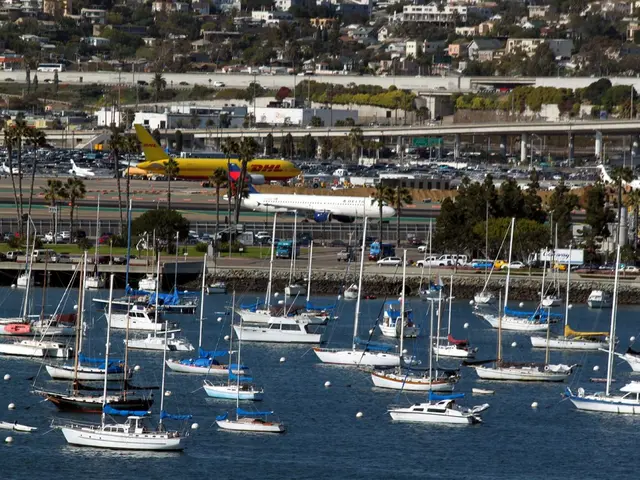Green investment surge gathers pace across Southeast Asia
Light Breeze of Green Revolution: Vietnam's Wind Energy Revolution and the Pursuit of a Sustainable Future
Vietnam's investment structure is evolving, focusing on wind energy, low-carbon transportation, and a broader shift towards a greener economy.
Hanoi - Southeast Asia needs a strategic approach to foster a green economy that enhances economic resilience, reduces emissions by up to 50% by 2030, and potentially adds $120 billion to regional GDP. This perspective lies at the heart of the sixth Southeast Asia Green Economy report, recently unveiled by Bain & Company in partnership with GenZero, Google, Standard Chartered, and Temasek.
The report titled SEA-6 Green Investment shows a 43% surge in green investment across Southeast Asia to $8 billion in 2024. Among SEA-6 economies, Vietnam stands out for its rapid growth in green investment. In 2024, Vietnam attracted $161 million in private green investment—roughly 2% of the SEA-6 total and down 19% year-on-year. The investment structure is evolving, transitioning from solar power into wind energy and low-carbon transportation.
SEA-6 comprises Indonesia, Malaysia, the Philippines, Singapore, Thailand, and Vietnam. Despite a slowdown last year, Vietnam now boasts one of the highest shares of renewable energy in the region, reaching 43%.
According to the report, the government is actively working towards a sustainable energy future by implementing national strategies like the Power Development Plan VIII (PDP8), the National Energy Master Plan, and the National Climate Change Strategy to 2050. It is also scaling up energy infrastructure, with about 3,000 EV charging stations being rolled out, and implementing mandatory emissions reporting for key industries. These actions align with the regionally recommended systemic solutions.
The report highlights systemic obstacles to green development, such as underdeveloped infrastructure, regulatory fragmentation, limited access to finance, and reliance on fossil fuels. Addressing these barriers requires combined efforts across energy, transport, land use, and industry. With Vietnam's commitment to net-zero emissions by 2050, the country is increasingly viewed as a regional leader in green transition efforts.
The report identifies key regional opportunities in transforming agriculture and land use (sustainable bioeconomy), modernizing electricity grids, and expanding electric vehicle ecosystems. In SEA, bioeconomy activities contribute up to 33% of employment but are also a significant source of deforestation and emissions. Reforms in land rights, supply chains, and natural capital management are crucial.
Grid modernization through cross-border interconnections and decentralized energy systems can support higher renewable integration. Green Industrial Clusters propose near-term models to attract private capital into renewable generation and transmission. Meanwhile, transport emissions continue to rise across SEA, and Vietnam, with its growing urbanization and industrial base, is encouraged to adopt a dual strategy of increasing domestic EV production while catering to growing consumer demand.
The report also emphasizes regional 'green corridors' as essential to accelerating fleet electrification, especially for commercial vehicles, while strengthening Asia-Pacific region cooperation could further boost value through shared investment and supply chain integration.
Financing Challenge
The increase in green investment in SEA-6 by 43% year-on-year masks an annual green finance gap of over $50 billion. To address this, Vietnam, like regional peers, must continue expanding blended finance models, simplify administrative procedures, and foster public-private partnerships.
International capital inflows are growing, with foreign investment in SEA-6 green projects tripling in 2024. However, domestic investment fell by 40%, indicating the need for more stable internal financing mechanisms.
Standard Chartered, which operates across ASEAN, reaffirmed its commitment to supporting Vietnam's transition. Nguyen Thuy Hanh, CEO of Standard Chartered Vietnam, emphasized the country's leadership in constructing a low-carbon economy, stressing that sustainable finance and regional cooperation would be pivotal for long-term prosperity.
Carbon market development is gaining traction. However, unlocking its full potential requires stronger policy frameworks, demand generation, and robust infrastructure. Vietnam, as part of regional efforts, is expected to align with international standards like ICVCM (Integrity Council for the Voluntary Carbon Market) and CORSIA (Carbon Offsetting and Reduction Scheme for International Aviation), to ensure credit integrity and investor confidence.
Artificial intelligence (AI) serves as both a risk and a solution. Data centers could contribute 2% to emissions by 2030, yet with clean energy and smart AI, they can help cut emissions significantly. Sectors like agriculture and energy could experience a 3-5% drop if countries like Vietnam invest in AI.
The window for climate action is closing rapidly, and it’s crucial to increase the pace and focus on practical solutions with immediate impact. Vietnam, with its ambitious targets and commitment to a greener future, is undoubtedly gearing up to be a regional leader in sustainability and green investment.
Đầm Nại wind farm in Ninh Thuận Province. Việt Nam's investment structure is evolving, shifting away from solar power into wind energy and low-carbon transportation. - VNA/VNS Photo
- The government of Vietnam is actively working towards a sustainable energy future by implementing national strategies like the Power Development Plan VIII (PDP8), the National Energy Master Plan, and the National Climate Change Strategy to 2050.
- SEA-6, comprising Indonesia, Malaysia, the Philippines, Singapore, Thailand, and Vietnam, is experiencing a surge in green investment, with a 43% increase year-on-year as of 2024, totaling $8 billion.
- In contrast to the regional average, Vietnam saw a 19% decline in private green investment in 2024, attracting $161 million, but still boasts one of the highest shares of renewable energy in the region, reaching 43%.
- The report identifies key opportunities in transforming agriculture and land use, modernizing electricity grids, and expanding electric vehicle ecosystems, while emphasizing regional 'green corridors' as essential to fleet electrification.
- However, there is an annual green finance gap of over $50 billion in Southeast Asia (SEA-6), requiring expanded blended finance models, simplified administrative procedures, and fostered public-private partnerships.
- The increase in green investment masks this funding gap, and domestic investment in SEA-6 fell by 40%, indicating the need for more stable internal financing mechanisms.
- Artificial Intelligence (AI) can serve as both a risk and a solution, with data centers potentially contributing 2% to emissions by 2030, but also helping to cut emissions significantly in sectors like agriculture and energy if countries invest in AI.







